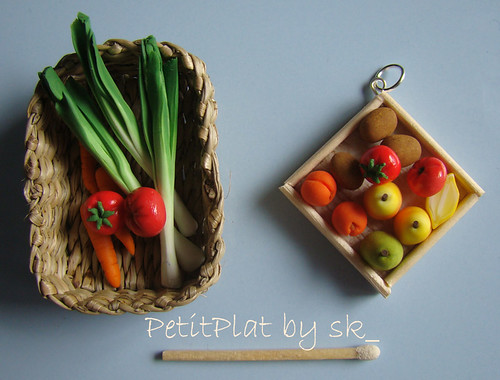How do I make fake food props? The props department is frequently called upon to make all manner of food and food replicas for the stage. When food needs to be eaten by the actors, the props director is in charge of making the food every night, either for real, or by figuring out a subsitute. If the food is not eaten, the props director has more latitude in choosing what to do, usually making the food out of a material that will last the run of the show. This article is about the latter type, where we make inedible but realistic fake food.

Research is very important here; a good reference, either a photograph or the real thing, will go a long way to help you capture the essence of the food. Notice in the photograph above how the tomato, orange, and potato are all distinctive and recognizable, even though their shapes are fairly similar.
Sometimes you need to do research just to decide which food to use. Jay Duckworth pointed me to a website with a food timeline. If your production of Twelfth Night is set in 1810, can you have Macadamia Nuts at the picnic (no, they weren’t around until 1828).
Ron DeMarco pointed me to an older article with photographs about the Milwaukee Repertory Theatre (boy, they get a lot of press!). Julia Powell, the principal craftswoman, describes her process for replicating food. Ron linked to another article about food on stage. Though it’s mainly about the preparation and adaptation of real food, there are some tidbits on constructing completely artifical food.
There are a number of other articles floating around the internet giving tutorials for specific types of food. “Shortone” has a cool Instructable on how to make fake cupcakes. Amy Sedaris (yes, that Amy Sedaris) has instructions for making a cake out of styrofoam and spackle. Between these two, you can get a good idea of how to replicate any number of pastries and desserts.
Michael Koslovsky has an article in Proptology describing how he made lettuce for a fake sandwich. Kyle May has a pictorial showing an interesting method for making fake ice cubes. The PropPeople forum has a few good food-related posts. Dead animals can be a particularly tricky kind of prop; here is one way to make a dead goat. Here are a few tips and ideas for making raw hamburger meat. The last one references an Instructable on making Playdough, which might be useful, though it uses flour.
There are, of course, countless places you can simply purchase fake food replicas. DMOZ Open Directory has a number of listings under “Fake Food Props“. Or just search for “fake food” or “food props”. One of the top New York City food replica shops is Trengove Studios, which is actually geared more toward photography and film. Though probably too expensive for theatrical work, the pictures of their products are great just to drool over.





Bathroom caulk makes awesome cake frosting (the brown looks like chocolate frosting) and it takes dye or tints. Plus you can use a piping bag to do all the fancy decorating.
I am trying to find good looking fake fish. I need fish that would be in the Netherlands like herring, cod, mackerel, and salmon. It is going to be used in a museum. Have any tips for where to find it or how to make it?
Hm, I’m not too experienced in buying fake fish. I would start with sportsmen/hunting stores, such as Cabela’s, or taxidermy shops which cater to fishermen. If you do an internet search for “replica fish”, you can find a number of businesses which specialize in creating any number of realistic fish models; some even specialize in museum pieces.
As far as making them go, most of the commercial products seem to be made of fiberglass. If I were approaching this problem, my first thought would be to make a mold and cast it in silicone or resin. The trickiest problem would be finding or creating the piece to make the mold from. Good research is essential to capture the most realistic details. I might even be tempted to go to a fish market and pick up actual fish to make a mold from.
Mmm, bathroom caulk.
you may want to check out Van Dykes taxidermy the fish are a bit dear in price. If you are working where people will be looking up close it may be worth it.
http://www.vandykestaxidermy.com/
jay